
| 
|  |
|
|
This page contains historical photos of Ontario's King's Highway 71 dating from 1936 to 1999. All photographs displayed on
this page were taken by the Ontario Ministry of Transportation, unless specifically noted otherwise. Historical photographs are arranged in approximate chronological
order. Click on any thumbnail to see a larger image!
Please note that all photographs displayed on this
website are protected by copyright. These photographs must not be reproduced, published,
electronically stored or copied, distributed, or posted onto other websites without
my written permission. If you want to use photos from this website, please
email me first for permission. Thank-you!
|
|---|
|
Page 1: Historical King's Highway 71 Photographs


Left - Circa 1936 postcard view of the Queen Post timber truss bridge on Hwy 70 (today's Hwy 71) at Nestor Falls. This rare photo postcard is the only known
surviving photograph of the original Nestor Falls Bridge, which shows a side view of the structure. The original span was a Queen Post creosoted timber truss bridge,
which was completed around 1934. The timber bridge at Nestor Falls was replaced during a highway widening project in 1939. The concrete rigid frame structure that
replaced this timber truss bridge still stands to this day on Hwy 71 (Former Hwy 70). Fortunately, this photograph was taken during the timber bridge's brief service
life, and provides transportation historians and road enthusiasts with a rare opportunity to see what the original Nestor Falls Bridge actually looked like. See an
Enlarged Photo Here. Photo taken circa 1936. (Photo courtesy of The Camera Shop, Port Arthur) Right - Circa 1937 postcard view of the western side of the newly-built Sioux Narrows Bridge on Hwy 70 (today's Hwy 71). This magnificent timber through truss structure was completed in 1936 as part of the final link in the Heenan Highway between Kenora and Fort Frances. With the main through truss span length coming in at an astonishing 210 feet (64 metres), it was by far the longest structure of this type ever built on the Ontario provincial highway system. The use of timber truss bridges such as this one came about by necessity. With highways being constructed into increasingly remote regions of Ontario by the 1930s, finding reliable local supplies of concrete, structural steel and other manufactured parts proved to be a significant challenge for the construction of long-span highway bridges. Engineers with the Department of Northern Development and the Department of Highways of Ontario (DHO) studied timber bridge construction techniques in British Columbia with great interest. This western Canadian province had successfully built numerous long-span timber highway bridges using creosoted Douglas Fir beams, including an impressive five-span timber through truss bridge across the Fraser River in Quesnel, British Columbia. Although the design was modified to better suit the site conditions, the Sioux Narrows Bridge was largely modelled after the Quesnel Bridge. By the mid-1930s, Ontario had become a fairly regular importer of creosoted Douglas Fir timber beams from British Columbia to aid in the construction of highway bridges at remote locations such as Sioux Narrows. The timber beams were brought out to the bridge sites either by truck or by railway. They were already pre-cut to a specified length and labelled with small metal tags indicating the position of each truss member. The bridges were then assembled by crews on-site under the supervision and direction of a field engineer. For those who haven't seen the Sioux Narrows Bridge in person, the true size of this bridge is a bit hard to fathom. The main timber truss span length is more than double the length of the elegant single-span concrete rigid frame bridges built along Hwy 400 between Toronto and Barrie. So to put that another way, you could actually fit two Hwy 400s side-by-side underneath this bridge! See an Enlarged Photo Here. Photo taken circa 1937. (Photo courtesy of The Camera Shop, Port Arthur) 

Left - Rock cut on Hwy 70 (today's Hwy 71) 17 miles north of Nestor Falls. Photo taken on September 2, 1939. (Photo courtesy of Ontario Ministry of Transportation - © King's Printer for Ontario, 1939) Right - Construction crew widening a rock cut on Hwy 70 (today's Hwy 71) 23 miles north of Nestor Falls. Photo taken on September 2, 1939. (Photo courtesy of Ontario Ministry of Transportation - © King's Printer for Ontario, 1939) 
Above - Completed grading on Hwy 70 (today's Hwy 71) beside Lake of the Woods at Red Deer Lodge, showing new fill. See an
Enlarged Photo Here. Photo taken on September 2, 1939. (Photo courtesy of Ontario Ministry of Transportation - © King's Printer for Ontario, 1939) 
Above - Circa 1940 postcard view of Hwy 70 (today's Hwy 71) at Lake of the Woods north of Nestor Falls. This interesting postcard shows a section of log guide
rail beside the highway. Log guide rails such as this were commonly used on Northern and Eastern Ontario highways in the 1930s and 1940s. Logs were utilized instead
of steel beam or steel cable guide rail, since the timber was readily available from highway right-of-way clearing operations. More importantly, these log guide rails
were very easy to install in remote areas, since no manufactured parts were required other than simple steel bolts. Log guide rails were installed to delineate
various roadside hazards, but they did not offer motorists much protection in the event that their vehicle left the roadway. These log guide rails were a temporary
measure, and were eventually replaced with steel beam or steel cable guide rail after the Post-War steel shortage eased in the early 1950s. Compare this photo with
the photo above from 1939, which shows a nearby section of highway facing in the opposite direction before the log guide rail was installed. See an
Enlarged Photo Here. Photo taken circa 1940. (Photo courtesy of Lakewood Studio, Kenora) 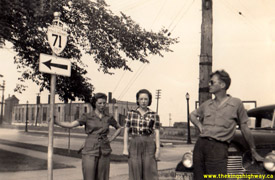
Above - American motorists standing beside a King's Highway 71 route marker sign in Fort Frances. See an
Enlarged Photo Here. Photo taken in August 1941. (Photo from Cameron Bevers' historical photograph collection - Original photographer unknown) 

Left - Circa 1940 postcard view of Hwy 70 (today's Hwy 71) between Emo and Kenora. (Photo courtesy of The Camera Shop, Port Arthur) Right - Circa 1945 postcard view of the Nestor Falls Bridge on Hwy 70 (today's Hwy 71), showing the new structure beside the site of the original timber truss bridge. See an Enlarged Photo Here. (Photo courtesy of Clarke & Crombie Publishing) 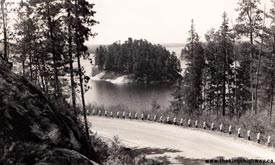
Above - Circa 1945 postcard view of Hwy 70 (today's Hwy 71) at Lake of the Woods near Nestor Falls. See an
Enlarged Photo Here. (Photo courtesy of Lakewood Studio, Kenora) 
Above - Spreading mulch asphalt on Hwy 70 (today's Hwy 71) south of Nestor Falls. Photo taken on August 1, 1947. (Photo courtesy of Ontario Ministry of Transportation - © King's Printer for Ontario, 1947) 
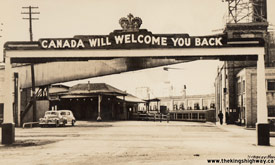
Left - Circa 1948 postcard view of the Fort Frances Welcome Arch on Hwy 71. This welcome arch stood for several decades at the entrance to the Fort Frances
International Bridge. Like many welcome arches of this era, the overhead sign featured neon tube lettering so that it could be illuminated at night. See an
Enlarged Photo Here. Photo taken circa 1948. (Photo courtesy of Hibbert-Neely Studios, Fort Frances) Right - Circa 1948 postcard view showing the opposite side of the Fort Frances Welcome Arch on Hwy 71. The Fort Frances International Bridge entrance and the eastern terminus of Hwy 71 lie just ahead. For many years, the Fort Frances International Bridge provided the only fixed highway link to the District of Rainy River. Until the mid-1930s, motorists had no choice but to drive through Minnesota in order to reach Fort Frances and Rainy River, as the Rainy River District's road system was not contiguous to the rest of Ontario's highway network. Once the Sioux Narrows Bridge was completed on the Heenan Highway south of Kenora in 1936, it opened up an all-Canadian highway route which connected Fort Frances and Rainy River to the Trans-Canada Highway. Motorists had to wait almost three more decades before a second all-Canadian highway link (Hwy 11) was completed between Atikokan and Fort Frances in 1965. See an Enlarged Photo Here. Photo taken circa 1948. (Photo courtesy of Hibbert-Neely Studios, Fort Frances) 

Left - New asphalt pavement on Hwy 70 (today's Hwy 71), 3 miles north of Nestor Falls. See an
Enlarged Photo Here. Photo taken on July 16, 1949. (Photo courtesy of Ontario Ministry of Transportation - © King's Printer for Ontario, 1949) Right - Early fingerboard guide signs at the Reed Narrows Bridge on Hwy 70 (today's Hwy 71) north of Sioux Narrows in 1949. See an Enlarged Photo Here. (Photo courtesy of Ontario Ministry of Transportation - © King's Printer for Ontario, 1949) 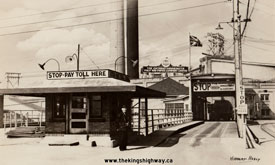

Left - Circa 1950 postcard view of the entrance to the Fort Frances International Bridge at the end of Hwy 71. This is one of two privately-owned bridge
crossings between Ontario and the United States. The other privately-owned bridge crossing is the Ambassador Bridge, which links Windsor to Detroit. See an
Enlarged Photo Here. Photo taken circa 1950. (Photo courtesy of Hibbert-Neely Studios, Fort Frances) Right - Circa 1950 view of Hwy 17 approaching the Hwy 70 Junction (today's Hwy 71) at Longbow Corners east of Kenora. This large directional "Y" intersection was reconfigured many years ago so that Hwy 71 ended at a T-intersection with Hwy 17. However, at the time this photo was taken, traffic had to turn rather sharply to the left in order to continue east along Hwy 17 towards Dryden. The apparent "through route" at this junction was actually Hwy 70, which began to turn south towards Sioux Narrows and Fort Frances beyond Longbow Corners. This through route appearance is further amplified by the highway's surface - note that Hwy 70 was paved with a marked centreline through the highway junction. Observers may notice that the pavement ends on Hwy 17 just beyond the split, where it becomes a gravel-surfaced highway. It wasn't until the early 1960s that an asphalt pavement was completed along Hwy 17 east of Longbow Corners. See an Enlarged Photo Here. Photo taken circa 1950. (Photo from Cameron Bevers' historical photograph collection - Original photographer unknown) 
Above - Aerial view of the timber through truss bridge on Hwy 70 (today's Hwy 71) crossing Sioux Narrows in 1951. See an
Enlarged Photo Here. (Photo courtesy of Ontario Ministry of Transportation - © King's Printer for Ontario, 1951) 
Above - Aerial view of Hwy 70 (today's Hwy 71) approaching Sioux Narrows from the south in 1951. See an
Enlarged Photo Here. (Photo courtesy of Ontario Ministry of Transportation - © King's Printer for Ontario, 1951) 
Above - International Bridge at Fort Frances, linking Hwy 71 with International Falls, Minnesota. See an
Enlarged Photo Here. Photo taken in 1951. (Photo courtesy of Ontario Ministry of Transportation - © King's Printer for Ontario, 1951) 
Above - Facing north along Hwy 70 (today's Hwy 71) showing new zone painting approaching the Rushing River Bridge south of Longbow Corners. Photo taken on August 27, 1953. (Photo courtesy of Ontario Ministry of Transportation - © King's Printer for Ontario, 1953) 
Above - Postcard view of Hwy 70 (today's Hwy 71) approaching Sioux Narrows in 1953. See an
Enlarged Photo Here. (Photo courtesy of Alex Wilson Publishing, Dryden) 
Above - Junction of Hwy 17 & Hwy 70 (today's Hwy 71) at Longbow Corners, facing west towards Kenora. See an
Enlarged Photo Here. Photo taken on September 13, 1955. (Photo courtesy of Ontario Ministry of Transportation - © King's Printer for Ontario, 1955) 
Above - View of Lake of the Woods from Hwy 70 (today's Hwy 71) at Nestor Falls in 1955. See an
Enlarged Photo Here. Photo taken on September 15, 1955. (Photo courtesy of Ontario Ministry of Transportation - © King's Printer for Ontario, 1955) 
Above - Granular base on Hwy 70 (today's Hwy 71) south of Longbow Corners at Sta. 175+00, Contract #1955-51. Photo taken on September 15, 1955. (Photo courtesy of Ontario Ministry of Transportation - © King's Printer for Ontario, 1955) 
Above - Circa 1955 view of Hwy 70 approaching the Hwy 71 Junction between Emo and Rainy River, facing south. This photo provides a rare view of the original
highway junction between Hwy 70 and Hwy 71, prior to the route numbering changes of 1960. That year, an extensive highway renumbering plan was carried out in
Northwestern Ontario, under which Hwy 11 was extended westerly from Nipigon to Rainy River. The entire route of Hwy 120 from Shabaqua Corners to Atikokan and a
portion of Hwy 71 were supplanted by the Hwy 11 designation. In turn, Hwy 70 was renumbered as Hwy 71. Today, this highway junction can be found where Hwy 71 and
Hwy 11 meet just west of Emo. See an Enlarged Photo Here. Photo taken circa 1955. (Photo from Cameron Bevers' historical photograph collection - Original photographer unknown) 
Above - Motorists standing beside a King's Highway 71 route marker sign near Rainy River, circa 1955. See an
Enlarged Photo Here. (Photo from Cameron Bevers' historical photograph collection - Original photographer unknown) 
Above - Facing east along Hwy 71 (today's Hwy 11) from Pinewood, showing granular base being compacted, Contract #1955-211. See an
Enlarged Photo Here. Photo taken on October 4, 1956. (Photo courtesy of Ontario Ministry of Transportation - © King's Printer for Ontario, 1956) 
Above - View of Lake of the Woods from Hwy 70 (today's Hwy 71) at Nestor Falls. See an
Enlarged Photo Here. Photo taken in September 1959. (Photo courtesy of Ontario Ministry of Transportation - © King's Printer for Ontario, 1959) 
Above - View from the Rainy River Ferry Landing at the end of Hwy 71 (later Hwy 11) in 1959. In this photo, the ferry is carrying westbound traffic from Canada
towards the United States. Note the new piers for the Rainy River International Bridge under construction in the background. Up until the completion of the new bridge
between Rainy River, Ontario and Baudette, Minnesota in 1960, motorists had to utilize a ferry service to travel between Canada and the United States. The old ferry
landing was located on Water Street, immediately upstream of the Rainy River International Bridge. Ferry service was discontinued in 1960, once the new bridge opened to
traffic. See an Enlarged Photo Here. Photo taken in 1959. (Photo courtesy of Ontario Ministry of Transportation - © King's Printer for Ontario, 1959) 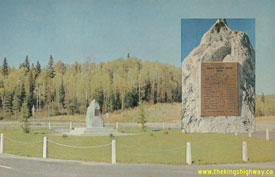
Above - Circa 1960 postcard view of the Great River Road Monument at the Hwy 17 & Hwy 71 Junction at Longbow Corners east of Kenora. See an
Enlarged Photo Here. (Photo courtesy of Alex Wilson Publications Ltd.) 

Left - Circa 1965 postcard view of the Fort Frances Welcome Arch on Hwy 11 & Hwy 71. See an
Enlarged Photo Here. (Photo courtesy of Alex Wilson Publishing, Dryden) Right - Circa 1965 postcard view of the eastern side of the Sioux Narrows Bridge on Hwy 71. See an Enlarged Photo Here. (Photo courtesy of Alex Wilson Publishing, Dryden) 
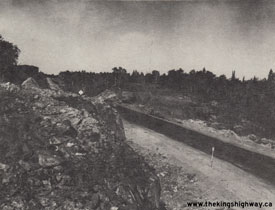
Left - New granular base on Hwy 71 south of Nestor Falls, Contract #1965-198. See an
Enlarged Photo Here. Photo taken in 1966. (Photo courtesy of Ontario Ministry of Transportation - © King's Printer for Ontario, 1966) Right - Excavator widening a rock cut on Hwy 71 north of Nestor Falls, Contract #1967-166. See an Enlarged Photo Here. Photo taken in 1968. (Photo courtesy of Ontario Ministry of Transportation - © King's Printer for Ontario, 1968) 

Left - Completed granular base on Hwy 71 north of Nestor Falls, Contract #1968-67. See an
Enlarged Photo Here. Photo taken in 1969. (Photo courtesy of Ontario Ministry of Transportation - © King's Printer for Ontario, 1969) Right - Heavy grading on a new alignment of Hwy 71 south of Longbow Corners, Contract #1970-173. See an Enlarged Photo Here. Photo taken in 1971. (Photo courtesy of Ontario Ministry of Transportation - © King's Printer for Ontario, 1971) 
Above - The front cover of the 1973 Ontario Official Road Map featured an aerial view of Hwy 71 north of Sioux Narrows as the background image. In this photo,
the Berry Creek Bridge can be seen at lower right, while the Reed Narrows Bridge can be seen off in the distance. Both of these bridges were built out of creosoted
timber in 1936. The Berry Creek Bridge was a timber through truss structure. It was essentially a miniature version of the more famous Sioux Narrows Bridge, which lay
a few miles to the south. The Reed Narrows Bridge was a long 34-span timber trestle structure, with a single pony truss timber span over the marine navigation
channel. Both of these historic timber structures were replaced with new concrete bridges in 1973. See an
Enlarged Photo Here. (Photo courtesy of Ontario Ministry of Transportation - © King's Printer for Ontario, 1973) 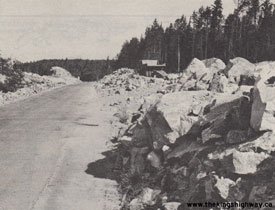

Left - Widening a rock cut on Hwy 71 north of Sioux Narrows, Contract #1972-185. See an
Enlarged Photo Here. Photo taken in 1973. (Photo courtesy of Ontario Ministry of Transportation - © King's Printer for Ontario, 1973) Right - Completed resurfacing on Hwy 71 south of Longbow Corners, Contract #1974-53. See an Enlarged Photo Here. Photo taken in 1974. (Photo courtesy of Ontario Ministry of Transportation - © King's Printer for Ontario, 1974) 
Above - Reconstruction of Hwy 71 north of Sioux Narrows, Contract #1975-6. See an
Enlarged Photo Here. Photo taken in 1975. (Photo courtesy of Ontario Ministry of Transportation - © King's Printer for Ontario, 1975) 
Above - Sioux Narrows Bridge on Hwy 71 before the sidewalk was added on the western side of the structure (1978) (Photo Courtesy of Walter Muma - © Walter Muma 1978) 
Above - Resurfacing and asphalt recycling on Hwy 11 & Hwy 71 west of Fort Frances, Contract #1980-230. See an
Enlarged Photo Here. Photo taken in 1981. (Photo courtesy of Ontario Ministry of Transportation - © King's Printer for Ontario, 1981) 
Above - Circa 1982 aerial view of the Sioux Narrows Bridge on Hwy 71 after the sidewalk was added on the western side of the structure (Photo courtesy of Ontario Ministry of Transportation - © King's Printer for Ontario, 2003) 

Left - Aerial view of the Sioux Narrows Bridge on Hwy 71 looking west (ca. 1990) (Photo © Harold Warkentin) Right - Aerial view of Sioux Narrows Bridge on Hwy 71 looking southwest (ca. 1990) (Photo © Harold Warkentin)
Continue on to King's Highway 71 Present Day Photos: Fort Frances to Emo
|
|---|
Links to Adjacent King's Highway Photograph Pages:
Back to King's Highway 70 Photos /
King's Highway 71 History /
On to King's Highway 72 Photos
Ontario Highway History - Main Menu / Back to List of Highways Website contents, photos & text © 2002-2025, Cameron
Bevers (Webmaster) - All Rights Reserved / Contact Me |
|---|